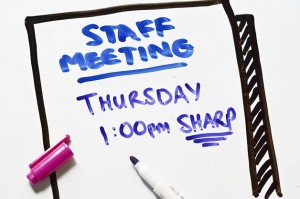 Meetings are an inevitable aspect of being a part of the workforce. An assembly of the minds is often needed within a corporation in order to make sure things are going in the right direction and running smoothly. However, sometimes it can feel as though there aren’t enough hours in the day to be productive with all of the scheduled conferences.
Meetings are an inevitable aspect of being a part of the workforce. An assembly of the minds is often needed within a corporation in order to make sure things are going in the right direction and running smoothly. However, sometimes it can feel as though there aren’t enough hours in the day to be productive with all of the scheduled conferences.
Mike Figliudo, founder of management consultancy thoughtLEADERS and author of One Piece of Paper: The Simple Approach to Powerful, Personal Leadership, conducted a poll asking “How much time do you spend in recurring meetings?” 30% of the respondents stated that they spent between 30-75% of their time in recurring meetings. What?! That time is crucial! Productivity is vital to making a company thrive, so start improving your tactics. Try utilizing these 5 simple steps to making your meetings much more efficient.
Cut the meeting time in half. Generally, most people do not mind short meetings. In fact, I can’t think of anyone ever saying, “that meeting was far too short.” Granted, those people may exist, I just have never encountered them. Try changing 1-hour meetings to 30 minutes, and even 30-minute meetings to 15-minute standups. Shortening the window of time for the meeting makes it clear that only essentials points need to be covered and speaks volumes for how much you value attendee’s time.
Whittle down the attendee list. I cannot tell you the number of meetings I have attended that have literally nothing to do with me, my current projects, my responsibilities, or even my department. I feel like a filler; a mistake on the part of Outlook when invitations went out. Save time and take a minute to narrow down your attendee list. If a few additional people could potentially use the information gathered from the meeting, shoot out a quick summary afterwards. It’s more effective for the company overall to have less participants.
Spend quality time on the agenda. Why are you calling this meeting? What’s the importance? What needs to be established? Going over the talking points and being prepared saves time and gives clarity to a meeting’s objectives. Stay focused. If a discussion seems to go off topic and becomes unconstructive, rein it in and get back on track. Clear agendas drive successful meetings.
Start on time. Nothing drags on a meeting more than waiting for latecomers. Do not waste valuable time waiting or giving recaps to stragglers. Making sure latecomers are up to speed only hurts those who were responsible enough to be on time.
Bonus: Being left out in the cold with incomplete information will force attendees to start arriving on time.
Come prepared. Arrive a bit early in order to ensure all computer/projector equipment, conference lines, etc. are up and running prior to the meeting. You don’t want to waste precious time fumbling with things during the meeting. It’s not only distracting but it shows a lack of preparation and effort. Additionally, make sure to bring any data, reports, or notes needed in order to present the issues effectively. You called this meeting, be kind enough to arrive prepared.
Change is good. Once you start implementing these modifications, your efficient meeting tactics will start to trickle down and even rub off on those around you. You will be setting a wonderful example because let’s face it, nothing can ruin a day like an unproductive meeting.
